|
ErikH2000
|
 |
« Reply #20 on: April 23, 2021, 09:48:28 AM » |
|
the animation feels a bit too jumpy. I understand that there's a grid system but perhaps it would look better if the transition is smoothed out a bit.
Fair comment. To some extent you're totally right and there remain things for me to improve. But there is a design decision to favor moving the player entirely to the chosen square and only show settling animation and tracers. It doesn't look as good, particularly when you as a video watcher don't know the move that will happen. But as a player, it *feels* good, super-responsive. And you never wait on the game. All that said, there are parts of the trailer that drive me nuts. Particularly, chain reaction things that are resolved instantly with not enough information to see what happened. I have more work to do there. |
|
|
|
|
 Logged
Logged
|
The Godkiller - a 3D puzzle adventure game that pits your character against God. Wishlist on Steam! |
|
|
|
ErikH2000
|
 |
« Reply #21 on: April 25, 2021, 12:41:07 PM » |
|
In June, I want to record all the voiceovers for the game I’m working on, a puzzle adventure game called The Godkiller. I used to run a VO studio, so I’ve got strong ideas of what works and what doesn’t. I want to give the actors standard-formatted scripts to read from. They look like this: 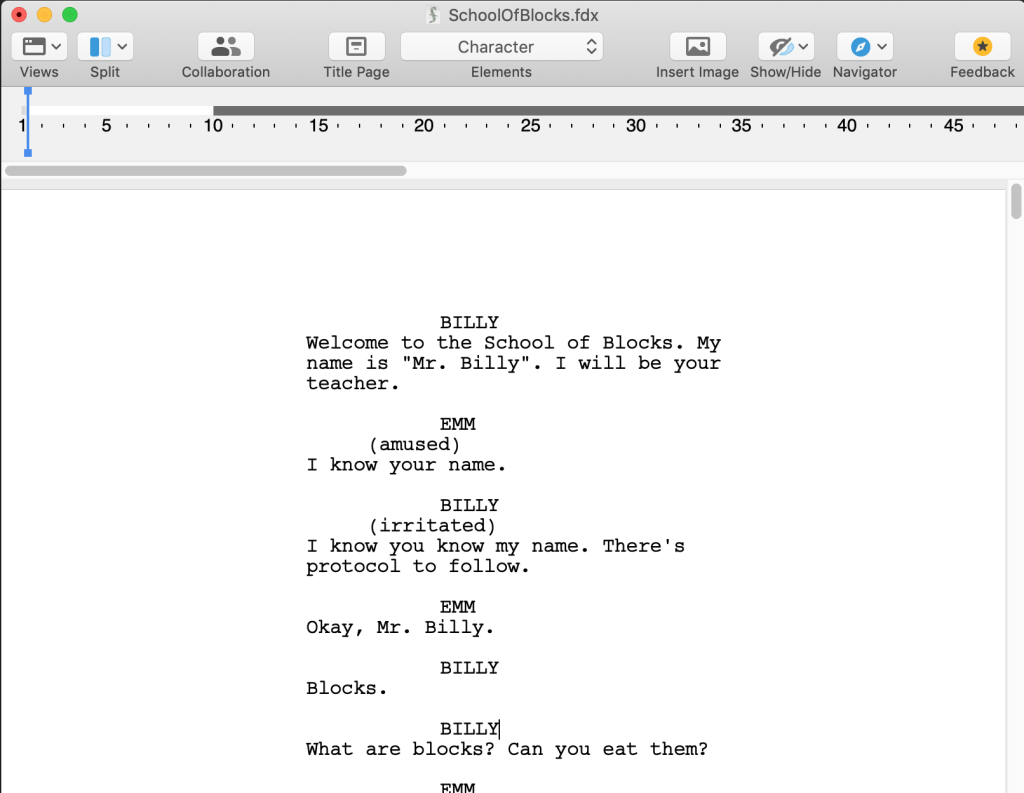 But where is almost all of my dialogue right now? It’s in code. The dialogue is so coupled to what the player does in the game, a source code editor is, honestly, the best place for me to write it. Often, I need to reference timing and spatial information about the level to decide if a line of dialogue will be “Yes, we should all go east.” or “Onward! Up the stairs!” For the sake of efficient authoring, all the things characters speak and emote in my game are in C# files like this. 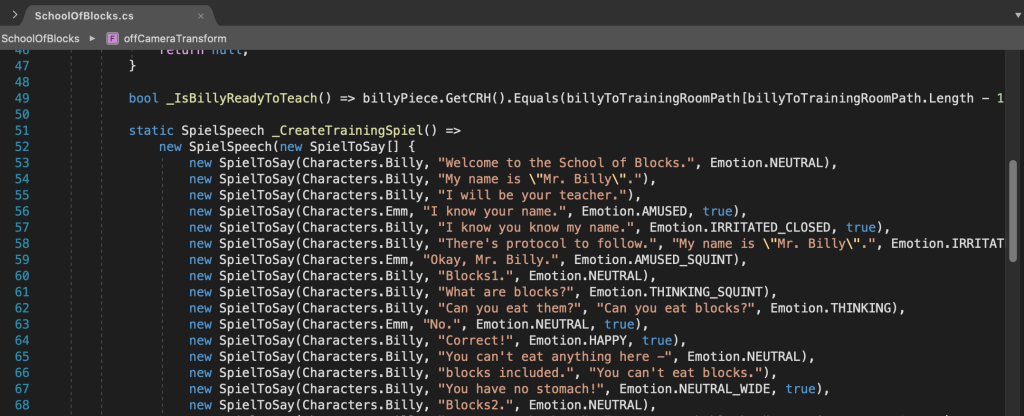 …which is a lot different than the target script format I want for actors. So I wrote a command-line utility yesterday that parses the source code files for dialogue and exports them to the FDX format that Final Draft (screenplay editing software) uses. Now, I’ve seen actors do just fine reading lines from spreadsheets and text files. But for best results over a wide variety of actors, I stick with the standard screenplay format. There are some inherent advantages like keeping the text easy to read quickly with a narrow, well-spaced lines. But mainly it’s just about following conventions that actors have already learnt to make VO sessions go smoother. | Standard Format | Janky Format | | Actors read more naturally. | Actors sound a bit off. | | Continuity of tone/emotion from line to line. | Retakes to get continuity. | | Lines read correctly. | Retakes for missed lines, words. | | Understanding of other characters’ lines. | Stilted reads that seem to miss context or correct reaction. | | Quick estimates of time needed in session (1 page = 1 minute of recorded dialogue) | Extra thinking/math around session planning. |
My conversion utility takes the emotions used for face animation (happy, sad, irritated, etc.) and exports them as parenthetical in the script format. If I left them as-is, it would completely over-specify the actors’ performances. I edit most of these out because I want the actors to be part of creating the best lines. By movie or television standards, the remaining parentheticals I have in my scripts would still be too much. If you look at a Hollywood script ( here’s one), the parentheticals are super-sparse. But in those cases, you’ve got actors that are studying, memorizing, and rehearsing scripts. In VO sessions, actors come in relatively cold and extra direction in the script saves time. The branching dialogue in a game can be a challenge to record, because it fills the script with “if condition A then say X” logic. And if I just let all these lines run together in the script, the actor may interpret them as happening linearly in sequence. So I generally group a branch of dialogue under a short explanation of the triggering criteria in the “action” section of the script.  Sometimes there is a line of dialogue that has multiple variants. It’s important to specify lines are variants, or the actor might try to read them all as continuous dialogue putting stresses in places that will sound strange. So I just do this: 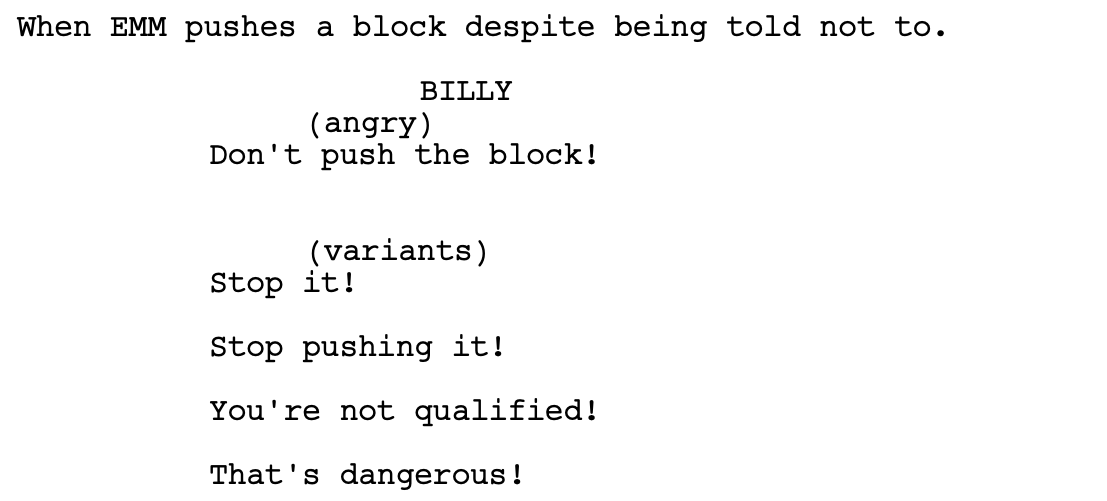 Later, once I have the VO session recordings from the actors, I’ll have to go in the opposite direction – making the game match the performance instead of the performance match the game. Here and there, an actor will improvise something hilarious, or we’ll give up on making a line work as written. Plus, the facial animation cues I’ve got in the game now might not match performances. But it’s a pretty efficient two-pass iteration, and I’d rather capture the better aspects of the performances than shoehorning the actors to the script. The Godkiller is releasing January 1st, 2022 for Windows and Mac. Wishlist on Steam! |
|
|
|
|
 Logged
Logged
|
The Godkiller - a 3D puzzle adventure game that pits your character against God. Wishlist on Steam! |
|
|
|
airbug
|
 |
« Reply #22 on: April 26, 2021, 03:22:52 PM » |
|
Curious why you chose to specify the dialogues in code. Why not have a JSON file (or something like that) you can load from your game? If you are planning to do localizations in the future, that may be easier with an external file as well.
|
|
|
|
|
 Logged
Logged
|
|
|
|
|
ErikH2000
|
 |
« Reply #23 on: April 26, 2021, 04:08:48 PM » |
|
Curious why you chose to specify the dialogues in code. Why not have a JSON file (or something like that) you can load from your game? Good question. In my case, the dialogue is tightly coupled to the logic that triggers it. So it's faster for me to write the dialogue in-line with the applicable logic. Otherwise, I'm continuously switching between two files, and spending time mapping to and from resource IDs. Once the English dialogue is finalized, I would choose to handle localization similar to what you described - with separate JSON files. And I'd likely extend the tool mentioned in the article to generate a list of source English in a format friendly to people translating, e.g. XLIFF or just a spreadsheet. |
|
|
|
|
 Logged
Logged
|
The Godkiller - a 3D puzzle adventure game that pits your character against God. Wishlist on Steam! |
|
|
|
ErikH2000
|
 |
« Reply #24 on: April 27, 2021, 09:52:39 AM » |
|
Not sure the proper way (or if there is one) to embed SoundCloud. If it doesn't show a nifty embedded player, but you still want to hear a silly song, just click the link below. https://soundcloud.com/erik-hermansen/whenisittimeformeIt’s supposed to make you cringe. But it’s short. This is the character, Billy, having a private, vulnerable moment to express how he’s been unfairly passed over in life. The vocals come from Kyle Chrise, who awesomely sings in his character voice. I wrote a bit earlier on the start of making this song (scan up the thread). There’s going to be about a dozen songs with vocals in The Godkiller. |
|
|
|
|
 Logged
Logged
|
The Godkiller - a 3D puzzle adventure game that pits your character against God. Wishlist on Steam! |
|
|
|
ErikH2000
|
 |
« Reply #25 on: May 02, 2021, 11:43:03 AM » |
|
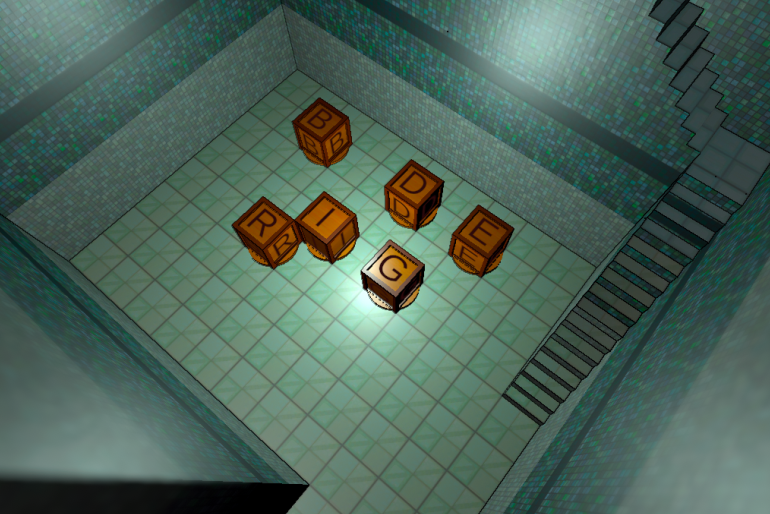 As I described earlier in the “My Trailer Needs Work” article, I’ve not done a great job of showing gamers what playing The Godkiller is like. They mostly yawned through my double-A cinematics and promises of a story-rich experience. But I am convinced the game mechanics are solid, fun, and, dare I say it… unique. Let me go over the basic verbs available to you as a player. Walking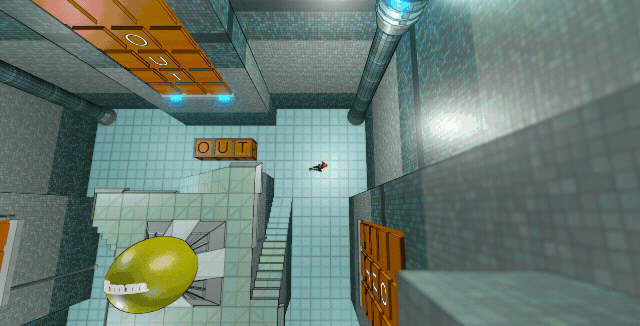 You can walk around in the four orthogonal directions. Each step moves you entirely into a square. It’s very quantized – you and other things are entirely inside of just one square / cuboid, and any animation along the way is incidental fluff. This is nothing new to puzzle gamers who’ve played games like Baba is You or DROD. (I want to write another article later on why grids are so great. They aren’t just retro.) Okay, walking… I know, big deal.  Stairs Stairs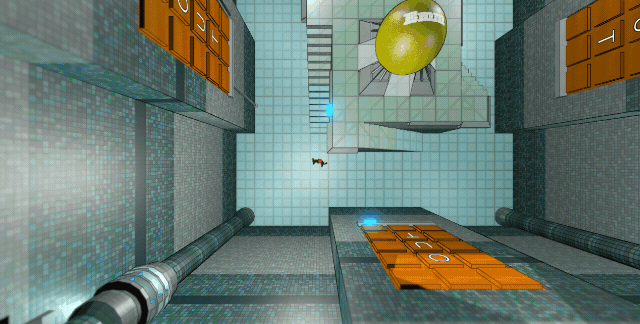 You can climb up and down stairs by walking. And you will not believe the sheer amount of staircases in this game. Falling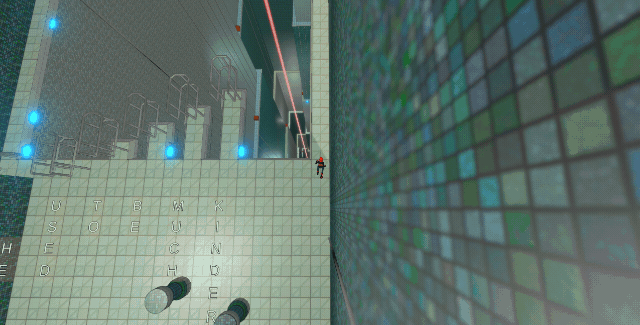 You can fall as far as you want as long as you remain in the bounds of the level. Early on, I wanted to be a purist and say you could never die from falling ever. But that would have meant I’d need to rail off any drops that would allow the player to go outside the level. Or make an impossible geometry solution like William Chyr did for Manifold Garden. (Add 3 years to my release date for that feature!) Still, it’s pretty satisfying to drop down a kilometer in gamespace on the super-vertical levels in the game, and just keep going like it ain’t nothing. Flinging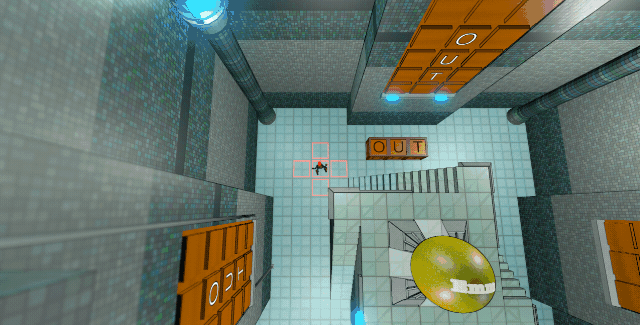 Here’s where it gets fun. Hold down on the shift key, and guide rays shoot out from your character to show where you can fling. Then press the arrow key in the direction you want to go, and you are instantly there. And I do mean instantly. No matter how far the distance, you will be there on the next frame drawn to the screen, with only settling animations and tracers shown. For videos, this gives people the carsickness effect – “too jumpy, show the animation better!”. For the game, it feels perfect, because you, the player, have decided where you want to go, and it’s joyful to have your decision enacted quickly. I don’t care if it makes my gameplay videos harder to follow, because it’s much more important for the game to feel good. Blocks and Letter Gates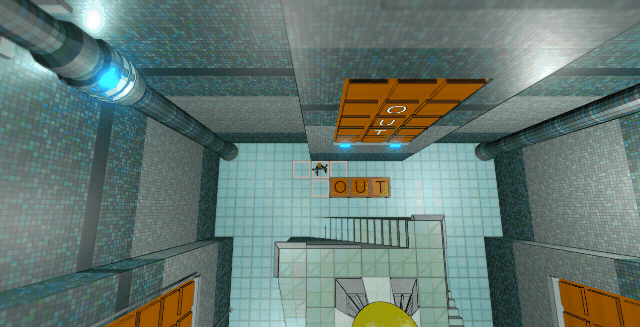 The blocks are a whole topic of their own (see “Top 5 Reasons Why My Blocks Are Not Soko-Ban Blocks” article). But let me explain how the blocks work with letter gates. I wanted something different than the normal ways of opening and closing doors in games. If you’re a puzzle gamer, you’ve worked through plenty of puzzles focused on getting objects to pressure plates or collecting keys. In The Godkiller, I just say that the doors (letter gates) have words on them, and if any blocks anywhere in the level spell the same word, then that door is closed, solid, opaque, and impassible. This general principle has a nice advantage that the player always can know what is keeping a door closed. You just read the word “out” on a closed door, and understand that there are some blocks somewhere spelling “out” that are creating that obstacle for you. You might have noticed looking at the GIF above that the blocks don’t behave like your standard pushable block. They fly across the room with a push, and you can destroy them at any time to reset puzzles without restarting a game. Letter Bridges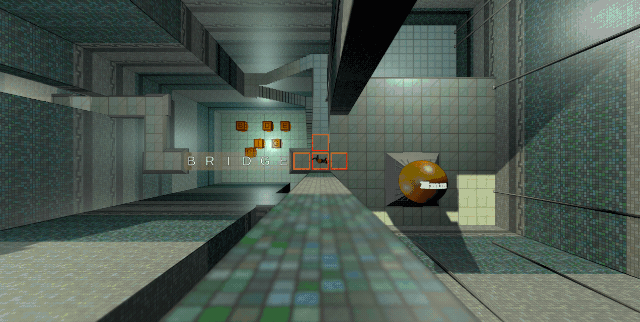 If I turn one of those letter gate “doors” on its side, it becomes a letter bridge – something you can walk across when it’s closed. And that unlocks a whole class of interesting spelling puzzles, where you arrange blocks to spell specific words to allow passage over bridges. Bridges follow the same principle as gates – if any blocks spell the word on them, they close. But it tends to be useful to make them closed/solid to reach places in a level. You’ll have to discard your Soko-ban instincts when you arrange these blocks. Because you can’t push them one square at a time, the shape of the walls and floors around them becomes more important. All the Other StuffI just covered the basics here. There’s a ton more different game elements like ice, spikes, rotating axles, and creatures that hassle you. But maybe this gives you an idea of what the game is like and why you might want to play it. The Godkiller is a 3D puzzle-solving adventure game under development. It will release January 1st, 2022 on Steam for Windows and Mac. Wishlist today! |
|
|
|
|
 Logged
Logged
|
The Godkiller - a 3D puzzle adventure game that pits your character against God. Wishlist on Steam! |
|
|
|
michaelplzno
|
 |
« Reply #26 on: May 02, 2021, 11:49:34 AM » |
|
I'm just here for a quick link to the bird song that I might hate.
|
|
|
|
|
 Logged
Logged
|
|
|
|
|
ErikH2000
|
 |
« Reply #27 on: May 02, 2021, 11:52:30 AM » |
|
Awesome! Eventually somebody's gonna say they hate it with a passion, and that will be okay. But so far, people have liked it.
|
|
|
|
|
 Logged
Logged
|
The Godkiller - a 3D puzzle adventure game that pits your character against God. Wishlist on Steam! |
|
|
|
michaelplzno
|
 |
« Reply #28 on: May 03, 2021, 05:32:59 AM » |
|
can you link me to the song tho? I think its sort of buried under a lot of other stuff.
|
|
|
|
|
 Logged
Logged
|
|
|
|
|
ErikH2000
|
 |
« Reply #29 on: May 03, 2021, 06:03:48 AM » |
|
can you link me to the song tho? I think its sort of buried under a lot of other stuff.
I just noticed how hard it is to get to the song on that video that I linked. I'll post a new video later today that has *just* the song in the game and not me writing code and mumbling. |
|
|
|
|
 Logged
Logged
|
The Godkiller - a 3D puzzle adventure game that pits your character against God. Wishlist on Steam! |
|
|
|
ErikH2000
|
 |
« Reply #30 on: May 03, 2021, 09:56:43 AM » |
|
Okay, here's the Plundy song played within the game.
Missing from the experience: bird animation and the voiceovers for the player's character, Emm. (Coming later.)
|
|
|
|
|
 Logged
Logged
|
The Godkiller - a 3D puzzle adventure game that pits your character against God. Wishlist on Steam! |
|
|
|
michaelplzno
|
 |
« Reply #31 on: May 03, 2021, 05:56:08 PM » |
|
Better than this one:
|
|
|
|
|
 Logged
Logged
|
|
|
|
|
ErikH2000
|
 |
« Reply #32 on: May 03, 2021, 07:01:46 PM » |
|
HehHeh. You don't like John Lennon? That's a classic song.
|
|
|
|
|
 Logged
Logged
|
The Godkiller - a 3D puzzle adventure game that pits your character against God. Wishlist on Steam! |
|
|
|
michaelplzno
|
 |
« Reply #33 on: May 03, 2021, 07:24:39 PM » |
|
Lennon? Always reading a book on Marx. Not a fan of the god stuff either. Lennon, that is.
You ever think that god wants people to rebel like one of those teenage things?
In terms of Beatles songs I think this one is much zazzier:
So I suppose I'm a theocratic constitutional monarchist who forces their agenda on others in typical Sagittarius fashion.
(I've been working on a character along those lines at least.)
|
|
|
|
|
 Logged
Logged
|
|
|
|
|
ErikH2000
|
 |
« Reply #34 on: May 04, 2021, 09:43:20 AM » |
|
You're hard to follow, but I like your style, sir.
|
|
|
|
|
 Logged
Logged
|
The Godkiller - a 3D puzzle adventure game that pits your character against God. Wishlist on Steam! |
|
|
|
ErikH2000
|
 |
« Reply #35 on: May 04, 2021, 09:53:32 AM » |
|
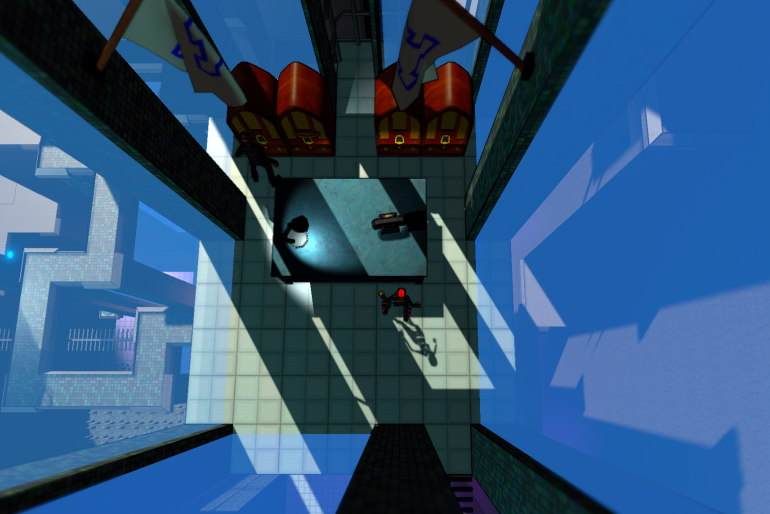 Ian Zimmerman sent me some new models yesterday, and I quickly put them inside my level. I was excited to see how they looked. He gave me just what I asked for: - One simple, metal desk. The kind you might find in a World War II military office.
- A fancy old radio.
- A wall-mounted flagpole that I could easily change the texture on.
And he threw in a lamp and a telephone since he was in a generous mood. I think it all turned out pretty well. This is about the maximum amount of cosmetic detail I want to add to a location in the game. The art style is pretty sparse for two reasons: 1. My budget is very small. I can’t afford to decorate every corner of the world to standards like Obduction or even, The Witness, which has a beautiful, but spartan, style. 2. My game relies on a limited visual vocabulary to allow the player to make sense of it. Limiting Visual VocabularyThe second point needs elaboration. Below is an image from just a bit earlier in the level before entering Baldface’s office. (Click for detailed view) 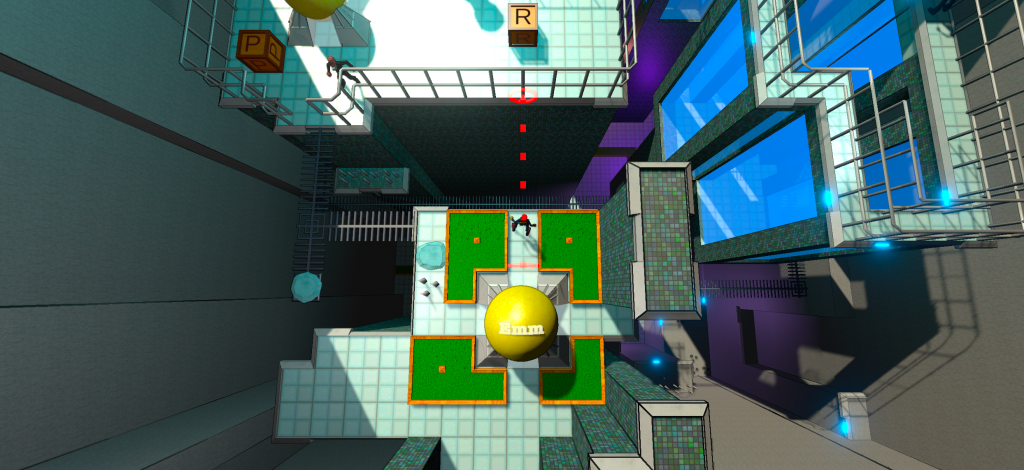 As a newcomer to the game, you won’t understand everything you see in the shot above. But since this level is about two-thirds through the game, a player will have been gradually introduced to game elements leading up to it. And they would recognize these learned game elements: - Emm – the player-controlled character in the center of the screen.
- Eggs – a spawn point. There’s one near Emm and one across the gap.
- Spikes – they kill you. There is one set of spikes near Emm. But you can spot some far below as well.
- Ice – you slip on it.
- Blocks – you push them, sometimes spelling words that close bridges.
- Beards – This enemy leaves you alone until you step on…
- Grass – the green squares that are against the law to step on, but you do it anyway.
- Rails – basic “wall” obstacles, with a few wrinkles.
- Grates – floor squares that you can walk over and see through.
Now, I could redo this screen to have a lot of lovely, special-cased artwork. The grass could look like a picturesque garden with flowers and pebbles. The ice could have more variety and not take up a full square. The rails could be pieces of rusty metal patched together in interesting ways. The floor tiles could lose the grid pattern and be replaced with some nifty industrial, brushed-steel that catches the glint of hanging overhead lights. But then you’d have more trouble making sense of the eight game elements described above. And your power to see and use a lot of information to solve puzzles is what makes The Godkiller fun. You’ve played Minecraft, right? You know when you see a block of coal ore far across a football-field-length canyon? It’s just a little black speck. But you recognize it because of a limited visual vocabulary. You saw many similar patterns earlier, and there’s consistency to how things are depicted in the game, so you can be confident in identifying something using maybe 64 pixels. Baldface’s OfficeSo for Baldface’s office, we pretty it up a bit, but not too much. (E.g. There’s no chair behind his desk.) And we keep those cosmetic elements away from the puzzles in the game. I think it works. 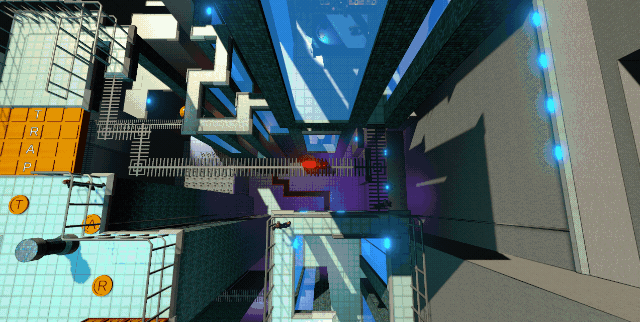 I really do want to put some moldings on those windows though. I’ll get to it. There’s a demo of this level in the video below if you want to see how those game elements work. So, to recap, there is a good reason, other than cheapness, to keep the art for objects in some games simpler and more consistent. It helps the player understand more complicated things.
The Godkiller is a 3D puzzle-solving adventure game under development. It will release January 1st, 2022 on Steam for Windows and Mac. Wishlist today! |
|
|
|
|
 Logged
Logged
|
The Godkiller - a 3D puzzle adventure game that pits your character against God. Wishlist on Steam! |
|
|
|
ErikH2000
|
 |
« Reply #36 on: May 07, 2021, 01:58:37 PM » |
|
The official title of the upcoming game I’m working on is “The Godkiller – Chapter 1”. Built into the title is the implication that there’s going to be more of the game coming. It’s maybe a bit arrogant-sounding. Even George Lucas didn’t call the first Star Wars movie “Star Wars I” (“IV”?), despite him having the story for nine movies planned out in his head. He went with the simpler “Star Wars”. You’re thinking… Who is this clown comparing himself to George Lucas and laying out multi-year sequel plans? Well, I’m releasing titles that are much smaller than multimillion dollar movies. I’ve made choices that don’t rely on outside funding or any kind of green-lighting. There is no publisher or studio for me to convince to fund a “chapter two”, and economically, I know how to keep going while putting out a title by being modest about its scope. Also, I’ve done the game franchise thing before. Below you can see titles from the DROD franchise that I created or contributed to. Though it must be said that Mike Rimer and the Caravel team were the main force here after the first three titles I released. 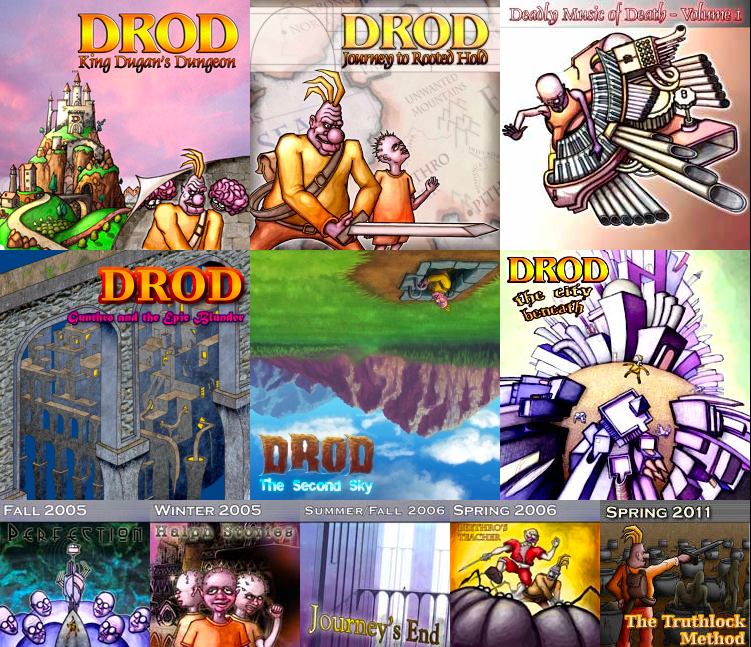 So developing a bunch of titles as part of a larger story is a practical undertaking for me. It follows successful patterns I’ve used before. What Will Be In Chapter One?Despite the DLC connotations of the name, Chapter One is a complete, self-contained game. I know from watching four puzzle experts play through it, that GK1 has got at least 20 hours of playtime in it. The story in Chapter 1 has its own smaller arc, with plot events leading to a satisfying ending. But Chapter 1 is also contributing to a larger story arc. Some events that will happen in later chapters are foreshadowed. Unlike Stephen King, I’m not making up the long-arc story as I go along. There’s about thirty pages of high-level outlines. It’s stuff like: Emm meets The King of the Ground, who offers her passage on the surface of the world. But only if she never leaves it. …except that’s not an actual event from the outline – it’s a slightly faked example. I don’t want to spoil the story for you! What Will the Other Chapters Be Like?Although, I have the complete story outline done, I don’t yet know how many chapters there will be. Like Chapter 1, I want each chapter to end strong, and have its own story arc. One thing I learned on Chapter 1 is that the game elements end up affecting the story a lot! So for example, I originally did not see much use for the pushable blocks in the game. I was a little fatigued of soko-ban blocks from playing so many games over the years that featured them. So the blocks were originally meant as props to represent a dreary form of slavery for a group of people. In their little society, they just pushed blocks around all day. 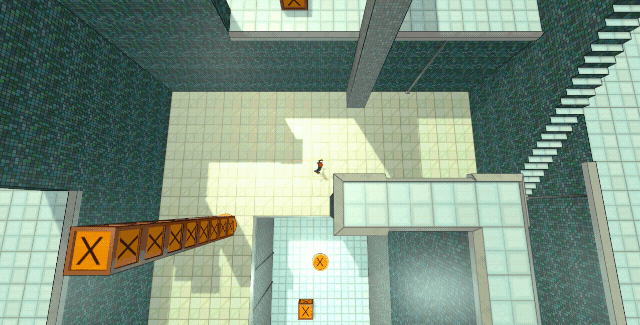 But then I found some tweaks on the blocks that warranted them being used in nearly every level within the game. At that point, I got very excited about pushable blocks! For an explanation of this, see Top 5 Reasons Why My Blocks Are Not Soko-ban Blocks. One section of the story blossomed as a result of the discovery of really fun game mechanics. And that placed the “cut” point between Chapter 1 and Chapter 2 much earlier. The game affects the story, and there’s discovery during development. That’s why I don’t pull a George Lucas and plot out nine movies/chapters in advance. Picking a Franchise NameThe first game I released commercially was called “Deadly Rooms of Death”. Years later, I discovered I wanted to make a sequel, and the name didn’t work that well for a story-based game. E.g. “Deadlier Rooms of Death”? So I ended up abbreviating the name to a “DROD” prefix, and myself and others wrote games like DROD: King Dugan’s Dungeon, DROD: Journey to Rooted Hold, and more. If I had understood at the beginning that I wanted to tell a story, I would have given the game a better franchise name. I’ve never been a fan of abbreviations. Why not call it “The Godkiller I”, “The Godkiller II”, etc.? I like the literary feel of “chapter” – it helps communicate that this is a continuing, linear story. Similarly, I’m not inclined to use the “franchise name:title name” style, e.g. Fallout: New Vegas or DROD: The Second Sky. It might be a marketing mistake, but I like the message of each title being a well-planned part of a larger story. Why not call it “The Godfatherkiller”? 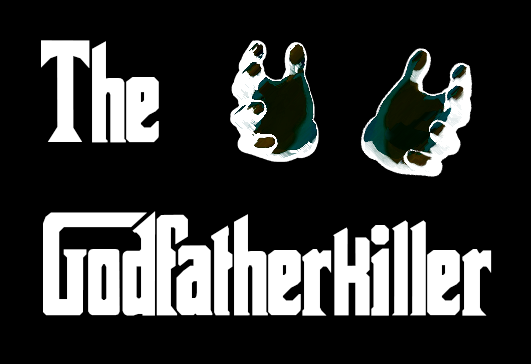 I don’t know. That would have been pretty cool. The Release Strategy – One Game Each Year (Probably)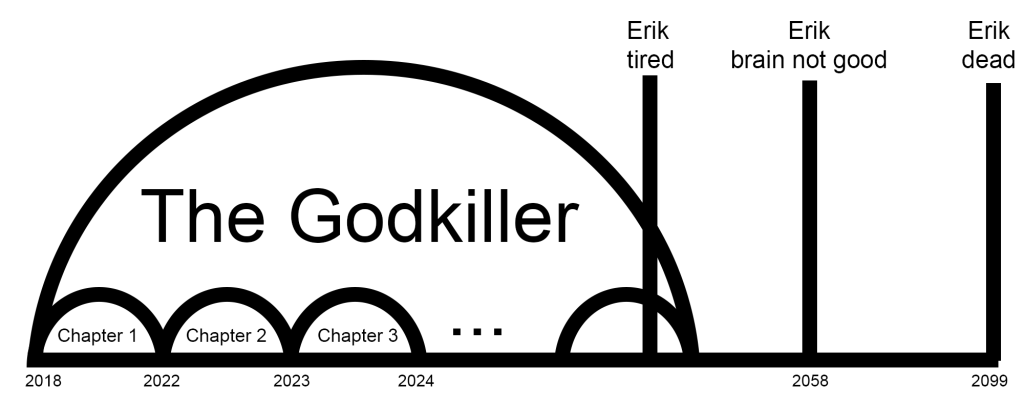 Though I’ve got some minor regrets over the “DROD” name, I don’t have any regrets over the way we released the games. We created a reliable game engine, built to last. We would update it with some new features and game elements on each release, and we’d create a bunch of new content in the form of levels, story, music, etc. The engine was maintained over two decades to release twelve titles on Windows, Mac, and Linux. There were no major rewrites or refactors to it. It was and remains a solid piece of software. I’ll follow a similar release approach for The Godkiller. The engine I’ve written over the last three years is also built to last over multiple titles. It is Unity-based, which wouldn’t satisfy Jonathan Blow, but there’s a deliberate under-reliance on 3rd-party assets and Unity features that might not age well. Worst case, I’m sure I could port it out of Unity if I needed to. New titles beyond the first Chapter 1 should be something like 90% content, 10% engine updates. So whereas it will take me 3.5 years to release Chapter 1, a Chapter 2 should be do-able within a year. I don’t have the roadmap confidence of a Marvel Studios, but my aim is to release one title per year. That seems like a realistic cadence based on my past experience and the amount of time I’ve logged on Chapter 1. Things can change or go really wrong. Maybe I go insane along the way and they lock me up in a padded room without any computer to write games on. But… I bet you Chapter 2 takes a year. I’m not alone in this low-engine-update approach. If you’d like to get more into the business side of this release strategy, check out Jeff Vogel’s talk below. The guy released 24 titles in 24 years!
The Godkiller is a 3D puzzle-solving adventure game under development. It will release January 1st, 2022 on Steam for Windows and Mac. Wishlist today! |
|
|
|
|
 Logged
Logged
|
The Godkiller - a 3D puzzle adventure game that pits your character against God. Wishlist on Steam! |
|
|
|
ErikH2000
|
 |
« Reply #37 on: May 11, 2021, 10:14:44 AM » |
|
In the VO recording world, no combination of gear and room construction ever gets you to Perfect. But let me be clear: this janky setup just barely works for my purposes, which right now is recording voiceovers and song vocals for my video game. 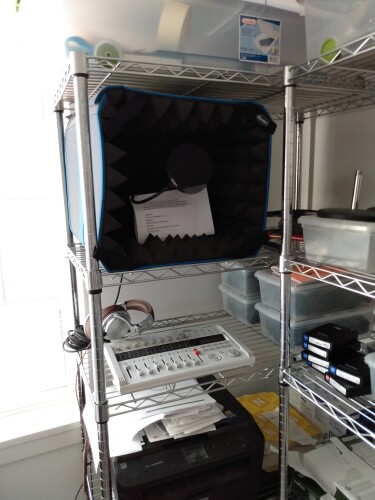 Okay, what are we looking at here? There’s a Porta-Booth foam-lined box at the top. I stick my head partially inside of it to record. It’s 10% more dignified than recording inside a sleeping bag fort. You might be getting excited about the Porta-Booth being a miracle replacement for a full-sized booth or treated room. But don’t rush out to buy one. For cutting down room reverb, it gets you maybe halfway to the deadness of a proper booth. And for best results, you have to ostrich-bury your head into the box. This is what I see when I record: 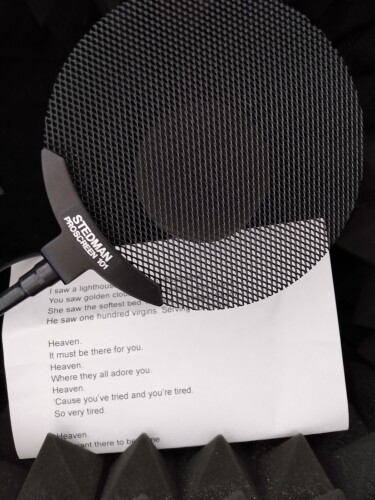 I’ve got the script tucked under the pop shield, and I make furtive glances down at it between lines, working to keep my mouth close to the mic. In the summer, this is a sweaty, fidgety effort. The mic is a Shure SM58, the AK47 of microphones – cheap, robust, reliable, and unremarkable. It’s very “good enough”. The mic plugs in via XLR cable into a Zoom R16, which records to an SD card.  In the past, I recorded directly to a laptop. But I found that a dedicated recorder like the one above gave me some advantages: - support for the cheaper XLR-based mics that I like
- recording with multiple mics plugged in (in pre-Covid times, I’d sometimes set up with 4+ VO actors recording together)
- no whirring of fans or hard drives
- no worrying about what might be running on a computer that competes for CPU or USB bandwidth
This model, the Zoom R16, particularly appeals to me because it doesn’t try to be too fancy. For example, it’s missing the EQ knobs of a typical console. Why would I want those? The audio is going over to the computer – I’ve got EQ and five million filters that can be applied in software. Generally speaking, a modern computer is a chaotic mess of little demons you have no control over. Your machine will get upgraded and manipulated in various ways at the whims of product managers at Apple, Microsoft, and Google. My DAW software will crash inexplicably. It probably has something to do with Software X never being tested with Software Y. We’re all running a complicated set of pending catastrophes on our machines, and it keeps getting worse. Jonathan Blow’s talk on this was great, if you want to go down that hole. Having a simple, dedicated piece of recording hardware keeps me sane. The only bad thing about using the Zoom is I have to ferry files over to my computer to work on them. 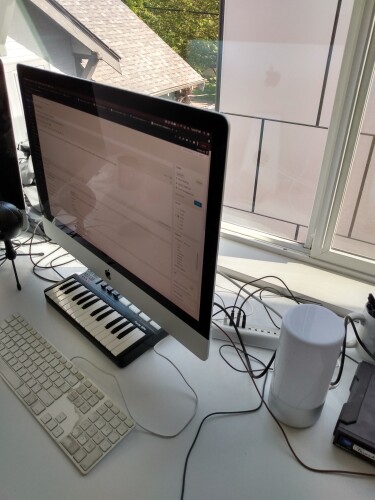 When I get ready to record, I listen for airplanes (I live by an airport) and the neighbor’s dog barking (he particularly hates my singing). And in the summer, there’s the extra step of turning off the fan and closing the door to my office. It’s terrifying how fast the room heats up after I shut the door. 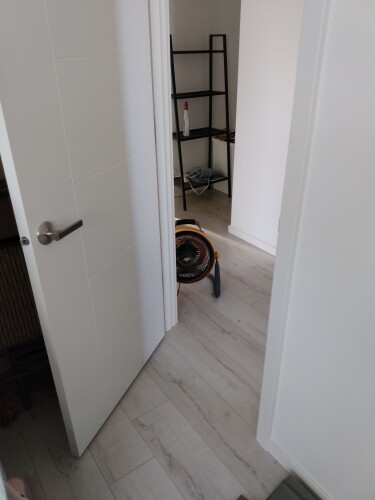 The video below is an example of results achieved with this janky setup. And by the way, I am not affiliate-linking any of this gear. The only thing I’m sorta pitching is my video game, The Godkiller, which will have about 90 minutes of recorded story dialogue in it, and a dozen songs with vocals. On the shelf next to this minor jumble of audio tech, are plans to build a Dawbox, which would be a proper recording booth. The kind you can put your whole body inside of instead of just your head. Oh, what a luxury that would be!
The Godkiller is a 3D puzzle-solving adventure game under development. It will release January 1st, 2022 on Steam for Windows and Mac. Wishlist today! |
|
|
|
|
 Logged
Logged
|
The Godkiller - a 3D puzzle adventure game that pits your character against God. Wishlist on Steam! |
|
|
|
ErikH2000
|
 |
« Reply #38 on: May 13, 2021, 02:04:27 PM » |
|
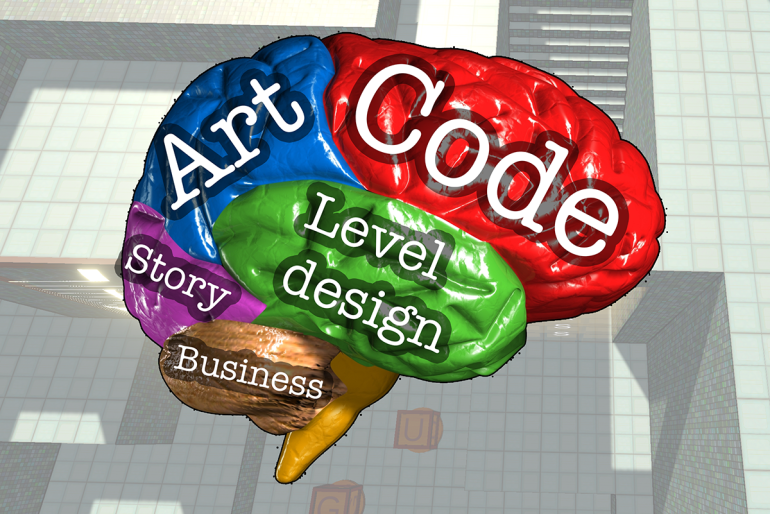 Years back, I was hired to work on games by Webfoot Technologies, a scrappy double-A studio that pushed out an impressive number of titles. I scripted a bunch of the levels on a Gameboy Advance title called Dragonball Z: Buu’s Fury. I’m going to pick on one part of the development process that was sub-optimal. But I hastily add that it’s a solid game – nothing to be ashamed of. People liked this game. I’ve talked to some of them. You’ve maybe heard of Dragonball Z and Funimation. Who do you think wrote the character dialogue for the game? Funimation. Not me. Not Webfoot. Super-definitely Funimation. Are they going to entrust a bunch of contract game developers to put words in the mouths of their beloved-by-many characters? Of course not! And they were understandably inflexible about making changes to the dialogue based on what the developers said. If the door wasn’t completely shut on feedback, I would have humbly suggested they cut down the length of some of the text. 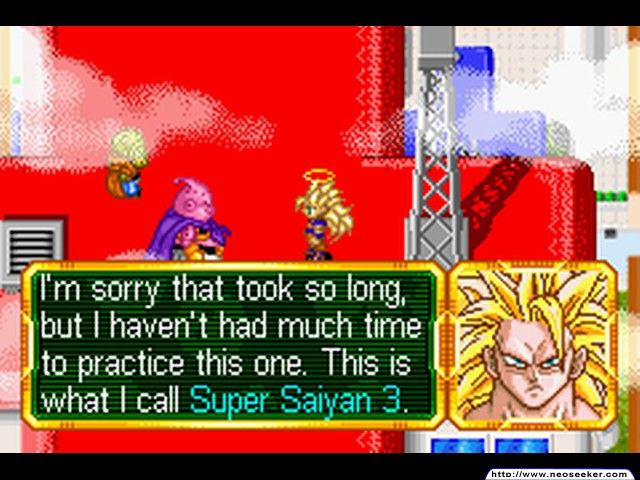 Imagine hitting the “A” button for five minutes on a handheld device to read paragraphs about the Triple-Super-Duper-Fusion-Saiyan transformation. But also, there’s times where the people writing dialogue should look at the game and draw inspiration from the level. You might notice for example, that Goku has walked up ten stories of stairs and have him say, “That’s a lot of stairs!” I’ve written tens of pages of dialogue by just staring at a level inside the scene view in Unity, and thinking… what would be fun to have happen here? The story and level design can influence each other iteratively. Also, you can pay attention to what playtesters are actually thinking and doing in the game to make an empathetic bond between the character and the player. (More about this in my “ What’s Better than Player Empathy?” article.) I’m not just spouting flimsy game design aspirations. I’ve made games like DROD where story is tightly meshed with the gameplay. Yestin Harrison wrote in his rebind.io review: Here is the crux of DROD’s genius: the story serves immersion. It is not separate from the levels; it is interleaved to the extent that it could not be separated. It is not the reward for solving a level; it is the level. Exactly. He gets it. Dragonball Z: Buu’s Fury was a game based on well-known IP, so the constraints are justifiable. Here, the “story” department was connected, via the thinnest corpus callosum, with the “dev” department. And information flowed in just one direction. Any typical modern software project with more than 5 people working on it will probably suffer from the same problem. Companies are trying to do big things fast, so they have different teams working on different aspects of production. There are cross-team meetings, specs, story bibles, mock-ups, and demos to help build a common vision of what the product is going to be. Scaling to deliver large projects requires you design the production effort to minimize communication. If you are making a large game, you do not want a massive all-hands general assembly with hundreds of people every day. Nor do you want five small cross-team meetings every day, pulling your developers, level designers, artists, musicians, etc. away from their desks where they could be getting work done. (mild to medium game spoilers for The Godkiller ahead)Now let’s head back to Indieland with me and my underdog game, The Godkiller, a Sokoban-like puzzler set inside a large story. My “team” is me doing 95% of the work and hiring a few specialists along the way. I will show you what I can do easily that an Activision or Electronic Arts cannot. I’m working on this level today. Here’s a quick shot of it halfway finished. 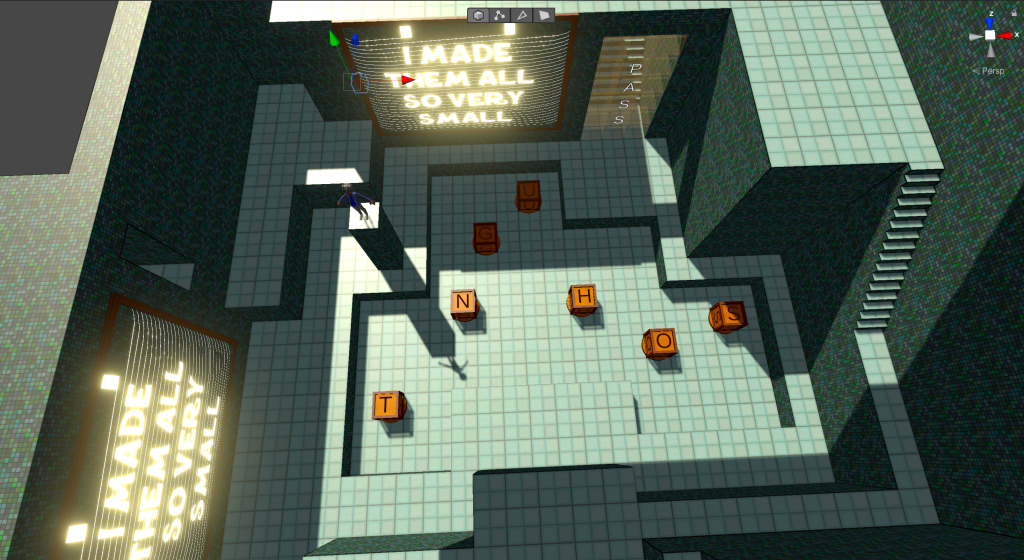 It’s a room where Emm, the main character, takes an “entrance exam” involving pushing some blocks around to spell words. If she passes the exam, she’s allowed entry into an exclusive, special place called the “All-Blocks Plateau”. You can see a little man standing on top of a column. (Apologies, I haven’t done the lighting in this level yet. You’re looking at Disneyland before the park is ready to open.) 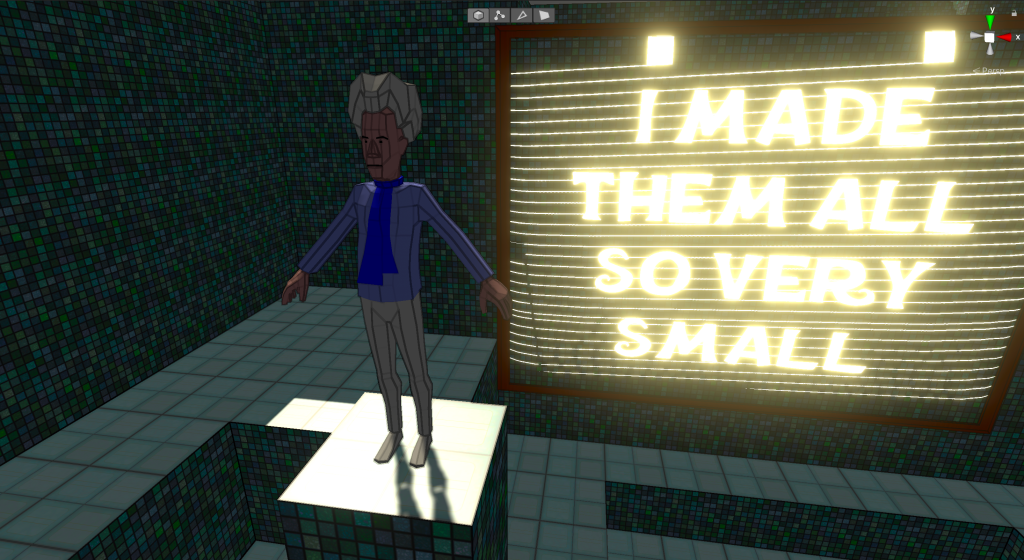 This guy’s name is “The Songleader”. His job is to administer the test. I was going to have a different character here called “The Proctor”, who would be a no-nonsense-but-fair sort of person. But the “project manager” part of my brain thought about using The Songleader instead, who is a character that already appears in a different part of the game. An artist, Bettina Throckmorton, is busy making animated face assets for The Songleader. 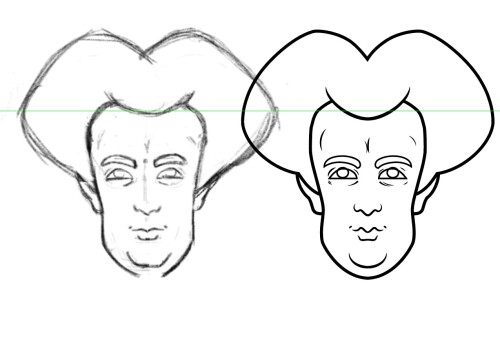 He’s a frilly, silly man. I’m already invested (with actual money) in this character, whereas I haven’t commissioned any art for the newly imagined “Proctor” character. The “story writer” part of my brain also wants a little more screentime for The Songleader so the player can get to know him. So I make a decision, quick and simple, to reuse The Songleader in this scene. And then I think… but he’s the song leader. In the other scene, which comes later, he actually leads a song and his name/title makes sense. And if this is the first scene that he appears in, the player will notice through game UI that he has this “song leader” title. So it seems like he should do something musical. I spent 30 minutes this morning writing a song that includes all the instructions the player will receive while taking the test. Go, go, go.
A word you know.
Spell it fast.
Or spell it slow.
But now, you must spell “go”.
Gut, gut, gut.
No stomachs, but
We can have a hunch
With some tiny luck.
Now, you must spell “gut”. …and there’s five more verses like that. I can hear the melody in my head. It’s got harpsichords. I’ll work it up in Logic X Pro later. Let’s be real – my song won’t be as good as a Jonathan Coulton masterpiece written for Valve. But it will be likable, fit the game well, and express me as the creator. And it will get decided upon and created in one-tenth the time that an AAA studio would take. The “developer” part of my brain understands exactly what should be done to make The Songleader begin each verse at the right time, in response to the player’s movements in the level. So in this quick “meeting” with the different parts of my brain, the “developer” nods his head like a curmudgeonly Gilfoyle. “It will work.” The conversation between the different parts of my brain roils. It’s thoughts like: - We should have Emm’s friends there. It will show that they’re important and give the scene some heart.
- But the friends are not admitted to the All-Blocks Plateau. Maybe there’s a visitor’s galley?
- But the friends are not admitted to the All-Blocks Plateau. Maybe there’s a visitor’s galley?
- You’ll want to update the level design to make a stairway from the visitor’s galley to outside the entrance.
- If you use those flickering screens in this level, it will lessen the impact of seeing them in a future level.
- But the player needs to know the current word to spell, and that was going to be on the screens.
- The song gives the current word. If the player forgets it, she can walk close to the Songleader and he’ll repeat the verse.
- Yeah, he loves to perform. He’ll gladly repeat a verse.
This is the kind of stuff that can take weeks of cross-team communication to figure out on an AAA title. And for me, it’s all done in one morning. Sometimes, it’s good to be indie.
The Godkiller is a 3D puzzle-solving adventure game under development. It will release January 1st, 2022 on Steam for Windows and Mac. Wishlist today! |
|
|
|
|
 Logged
Logged
|
The Godkiller - a 3D puzzle adventure game that pits your character against God. Wishlist on Steam! |
|
|
|
ErikH2000
|
 |
« Reply #39 on: May 18, 2021, 04:54:49 PM » |
|
 If you’re “all business”, and just want to get to the casting call stuff, skip to the last section of this article. The Game is Story-Complete!I finished writing all the dialogue for The Godkiller. And all the level scripting that triggers the dialogue. So the game is what I call “story complete”. I describe this whole process in more detail in the “What Do Game Actors Need? Scripts!” article. Mild story spoilers in the images below.The screenplay-format doc that contains all the dialogue is 130 pages long. It looks like this: 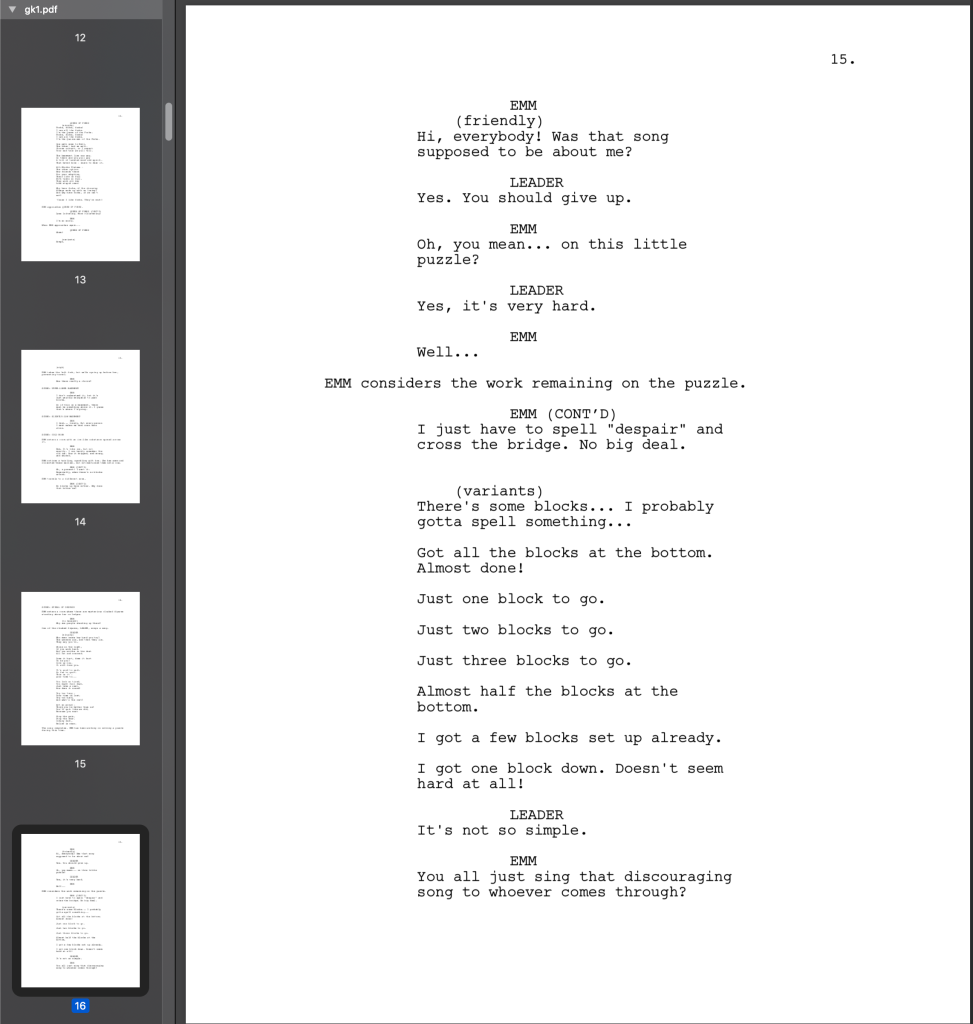 130 pages – is that a lot? For context, that’s about the length of a typical feature-length movie, e.g. the script for Good Will Hunting is 122 pages. At one minute per page, we’ll have over two hours of recorded dialogue going into the game. A “completionist” player will probably hear about 95% of it. The game is also designed to accommodate players that don’t want any story at all. Just turn off subtitles, set speech volume to 0, and you can progress through the game, oblivious to and unimpeded by all this story stuff. To keep my schedule, all the dialogue needs to get recorded in June. So it’s time to cast parts! I made a spreadsheet to track all the roles and where I am with each one. 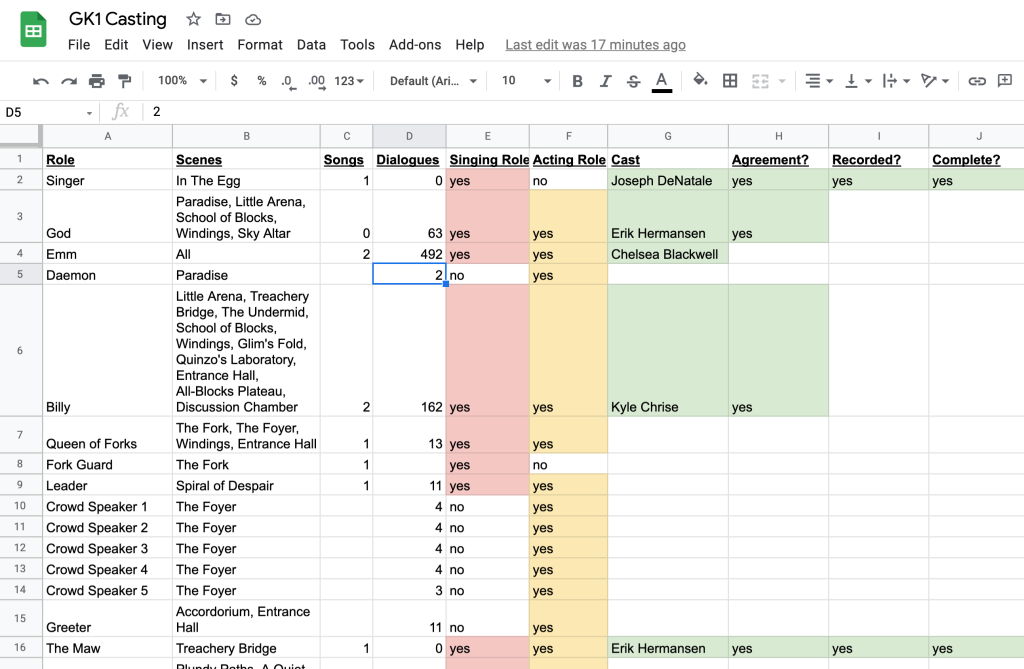 The spreadsheet keeps going. There’s 48 roles to cast. Some of them need actors that can sing. (Or singers that can act!) I ran a voiceover studio for a year, produced a comedy audio drama, and made some games with voice acting. So I feel pretty confident about getting this done. The only thing that’s a little new to me is casting singers. But now that I’ve got a five songs with recorded vocals in the game, the fear pangs are dying down. Don’t get me wrong – I know that it’s not the best music. These aren’t songs that impress people. But I think they’ve got “likability”, which is often the best thing an indie can aspire to. When I play Slay The Spire, for example, I’m not impressed by the artwork like I am the art that appears on Magic the Gathering cards. But I like the bird cultists and the dog with syringes sticking out of it. It’s weird. It’s neat. I can feel the people behind it expressing themselves. Finding The ActorsI’ve cast the two largest parts (Emm, Billy) to people I’ve worked with in the past (Chelsea Blackwell, Kyle Chrise). Check out Chelsea’s demo reel – she’s a killer!  There’s two things that slow me down on using more people from my personal network: 1. For accounting reasons, it’s difficult for me to contract with people in my home state of Washington. It can be done, but due to state requirements, it’s much easier for me to work with people in other states or countries. (That eliminates about 75% of my tried-and-true talent pool!) 2. Not all the great actors I’ve worked with are good singers. For the larger roles, I want to cast people that can sing in key and lift the song somewhere. (OMG, wait until you hear Chelsea Blackwell sing! I’m pretty sure I can put out a casting call on backstage.com and get a bunch of responses. I did that before. It worked very well. And I had reasonable luck finding singers at soundbetter.com. Though honestly, I don’t like contacting six singers to find one that answers and wants to work. I think there’s a lot of dead accounts on there. Discord and Developing TalentI’m going to try casting through Discord this time. I like how the problems of sharing files, chatting, and having live sessions are all solved in one place. And Discord feels fun and collaborative. We can do table reads on Discord. We can get two actors on a voice channel together to work out a scene. And there’s a nice community of talent over on the VO Town server. The only problem with VO Town is that it’s full of teenagers and hobbyists. Now, there’s nothing wrong with teenagers and hobbyists – most of us have been both of these things at one point. But I can’t use anybody under the age of 18 for legal reasons. (Too much hassle to get a guardian’s signature on a release form, plus my game is “mature”.) The hobbyists are often talented enough to cast, but lacking a recording environment that will work for the production quality of my game. There’s a category beyond “hobbyist” that I call “developing talent”. This is someone who doesn’t have a ton of experience, is not yet making a living from VO, but they’re on the path. They janked together some sleeping bag fort thing to kill the reverb, and know the schedule of the train that runs by their house to avoid recording it in the background. They know what “clipping” and “sibilance” means. Maybe they don’t work with ProTools, but Audacity or Reaper is their playground. They can tell you who voices Homer Simpson or The Joker. They’ve got a demo reel, even though they’re super-cringey about it. I love the “developing talent” crowd. My old VO studio was all about working with these folks. The Casting CallsI’m going to post casting calls for the upcoming parts in both VO Town and on the Seespace Labs Discord server, which you are welcome to join.
The Godkiller is a 3D puzzle-solving adventure game under development. It will release January 1st, 2022 on Steam for Windows and Mac. Wishlist today! |
|
|
|
« Last Edit: May 18, 2021, 05:04:01 PM by ErikH2000 »
|
 Logged
Logged
|
The Godkiller - a 3D puzzle adventure game that pits your character against God. Wishlist on Steam! |
|
|
|
 Community
Community DevLogs
DevLogs The Godkiller - a 3D puzzle adventure
The Godkiller - a 3D puzzle adventure Community
Community DevLogs
DevLogs The Godkiller - a 3D puzzle adventure
The Godkiller - a 3D puzzle adventure
